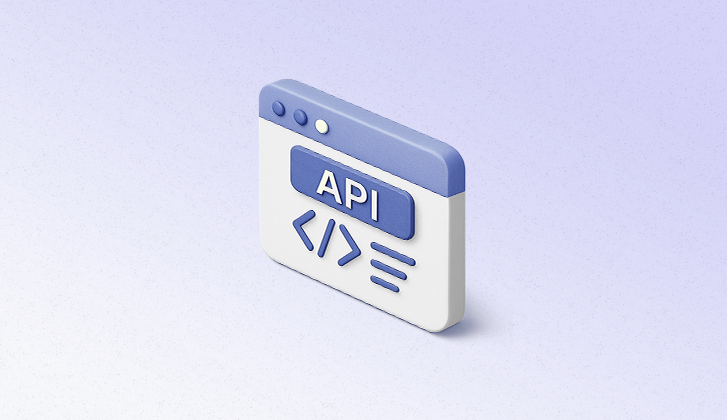API-first: Why it’s a winner for B2B products
From SaaS platforms to custom client solutions and multi-tenant systems, B2B products are complex. You’re building a system that needs to fit many requirements across web, mobile, internal teams, external partners, and often, other clients’ systems, all while being friendly for developers to integrate and for users to navigate.
If you’ve worked on a product with multiple clients before, you’ve probably experienced the pain of unclear interfaces, inconsistent data handling, or blocked teams. It can be one massive headache.
API-first can fix all that by putting the API at the center of the development process, treating it as a product on its own. According to Postman, the average application is powered by 26 to 50 APIs, so it makes sense that APIs should be at the center of your product strategy.
This approach delivers many technical and operational benefits not just for modern B2B, but for many projects. Let’s explore API-first in more detail, shall we?
What is API-first?
API-first means you design your API before anything else - before you write back-end logic, set up a database, and shape the UI. The API becomes the central contract on which every part of your product relies and every team builds against.
You typically start by creating an API specification that defines endpoints, methods, data formats, and expected behaviors. That spec becomes the single source of truth for everyone involved.
Product teams are increasingly adopting API-first. 74% of respondents in the Postman’s State of the API report identify their organisation as API-first, a significant increase from 66% in 2023. And with good reason.
This approach promotes clarity early on because it forces your team to think (and talk together) about how data and services will be structured before implementation starts. It usually requires more effort at the start, but it’s a fair compromise for reaping the benefits later on.
API-first principles
Shifting to an API-first approach is more than just changing the order of how you build, it requires a mindset and even a company culture shift. To get the full benefit, especially in a B2B environment where reliability and scale matter, you’ll want to go by a few key principles:
Standardization is non-negotiable
To make your APIs predictable and easy to adopt both internally and externally, consistency is critical. That means adhering to defined norms and industry standards like OpenAPI for naming conventions, HTTP methods, status codes, authentication, etc.
Clients don’t want to learn a new pattern every time they call a different endpoint. Consistency builds trust and reduces onboarding time.
Treat documentation as a product feature
Your API docs should be treated as a strategic asset because they will be critical for developer experience and adoption. Make them clear and up-to-date, include code examples and use case guides. You can also generate them automatically from your OpenAPI spec where possible.
39% of developers say that inconsistent docs are the biggest roadblock. Clear docs are essential when your clients' developers are trying to integrate your product under tight timelines or across complex stacks.
Design for reusability
Reusability reduces technical debt, simplifies onboarding, and makes it easier to build new services without rewriting core functionality. Avoid one-off, tightly coupled endpoints. Instead, design services and APIs that are reusable across products and teams. Think about:
- Can this endpoint serve multiple use cases?
- Is the logic embedded in the front end when it should be in the API?
- Will future teams be able to build on top of this?
Think about security from day one
APIs are often the front door to your data and business logic, so don't treat security protocols as a layer that you can add later. Your clients expect enterprise-grade security. A weak API security could cost you deals, compliance headaches, or even data breaches.
Implement feedback loops early
As with any product strategy, timely feedback is key. Try to get feedback as soon as possible from internal teams (front end, mobile, QA) who will consume the API, customers or partners who will be integrating with it, and developer advocates.
Use that feedback to improve both design and documentation. The API is part of your product experience. If it’s confusing or frustrating, you’re creating friction that slows adoption.
Why go API-first?
So, we talked about what API-first means and key principles, but what tangible benefits can you expect from adopting this approach? Let’s go over them.
B2B products live and die by integration
From syncing data to enabling partners to build on top of your platform, smooth integrations are expected in B2B. An API-first approach ensures your product is built from day one to be easy to extend and plug into existing systems.
For example, Bank BRI, a major Indonesian bank, leveraged Apigee’s API management platform to reduce partner onboarding time from a lengthy 6 months to less than 1 hour.
Teams can work in parallel
With a well-defined API in place, your front-end, back-end, and mobile teams aren’t waiting on each other to get started. Everyone works off the same contract simultaneously, building their respective components without waiting for dependent services to be fully implemented.
This reduces bottlenecks and speeds up delivery without compromising quality or creating chaos. Over 75% of respondents in Postman's 2023 survey agreed that developers at API-first companies are more productive, make better software, and integrate faster with partners.
Better developer experience
Clear API documentation reduces guesswork. Developers know exactly what to expect, what endpoints are available, what data they return, and how to handle errors. Your team will spend less time on back-and-forth meetings and refactoring code, improving productivity and speed.
Faster go-to-market
It’s true that with API-first you can expect longer planning sessions at the start, but it quickly pays off. Once development begins, things will start to move a lot faster and more smoothly. Features get built faster, tested earlier, and shipped with fewer integration issues.
For example, after a major shift to an API-first strategy, Nationwide Insurance managed to decrease development cycles from months to just a few days.
Similarly, GEM Health, a healthcare provider, estimated that building their virtual-first care platform without leveraging Healthie's API-based infrastructure would have doubled their development time.
Easier maintenance and scaling
With API-first, changes are more controlled and predictable because the API is treated as a stable contract. This makes it easier to evolve your system, add new features and support additional clients without breaking things.
New streams of revenue
With API first, you can explore new monetization models like pay-per-use API tiers, developer platforms, and partner ecosystems. What starts as an internal contract can turn into a commercial offering that extends your product’s value and reach.
An Oxford Economics survey found that companies invested in using APIs for external partnerships report higher annual revenue growth (6.7%), compared to other respondents (4.9%).
Building for the long-term
Your system needs to scale, evolve, and support new clients and use cases over time. API-first enforces clear contracts, consistent data handling, and modular design from day one so you can future-proof your B2B product.
API-first in action: Real-world success stories
Stripe
Stripe is a textbook example of API-first done right. They treat their API as the product. Every feature is exposed via clean, consistent, and well-documented APIs. Their developer docs are excellent, making integrations easy and fast, even for teams without much payments experience. Stripe’s API-first approach has helped them scale quickly and build strong trust among developers.
Twilio
Twilio took something complex (telecoms) and simplified it into five intuitive API calls. They made an entire industry more accessible to developers and improved how communication features are integrated into apps. Their business model relies heavily on direct monetization through usage-based pricing for API calls.
Amazon (AWS)
In the early 2000s, Amazon required that every internal team expose their services through well-defined APIs. This move forced modularity, improved internal collaboration, and laid the foundation for what eventually became AWS.
API-first Alternatives
API-first vs Frontend-first
One competing alternative to the API-first approach is frontend-first, where the UI/UX is designed first, often with mocked APIs. The back end is then developed to support the front end.
Pros of frontend-first
- Faster prototyping: You can quickly get something visual in front of users or stakeholders.
- User experience focus: Decisions are driven by what feels best for the user, not by back-end limitations.
- Feedback loops: Designers and front-end devs can iterate rapidly, often without back-end involvement early on.
But here’s the catch:
- Back-end bottlenecks: Eventually, the back end has to catch up, and without a clear contract up front, this can lead to misalignment, blockers, or rework.
- Harder to scale: If you want to turn your internal API into a public SDK or developer platform, you’ll likely need to refactor large chunks of your codebase.
- Code duplication and inconsistency: Without an agreed-upon source of truth, services tend to get messy, with less reuse and more one-off implementations.
API-first vs Code-first
Code-first means building your back-end logic first, then generating or documenting APIs from your existing code.
Pros of code-first:
- Fast for backend-heavy teams
- Quick setup for small or internal projects
- Good if your APIs won’t be shared externally
Code-first cons:
- API design becomes reactive, not intentional
- No clear contract for other teams to build against
- Difficult to version, scale, or reuse effectively
Code-first is fine for small or backend-centric projects, but the lack of upfront structure makes it less suitable for multi-team or integration-heavy systems.
The trade-off
API-first often takes a bit more time upfront - planning, designing, and agreeing on the contract. But the payoff is a more robust, scalable system where teams can move fast without stepping on each other.
Neither approach is right nor wrong. It depends on what you’re building. But for anything that needs to scale, integrate with partners, or serve multiple clients or platforms, API-first tends to win in the long run.
How to implement API-first

So you’ve decided to go API-first - great move. But how do you make it happen in a new product or business? Here’s a checklist and key questions you can run against your team to make sure you're going down the right path:
1. Agree on goals
What does the API need to do?
Before you dive into design tools or data models, get everyone aligned on what the API is meant to do. Is it powering your product UI? Serving external partners? Enabling automation for your clients? Define the purpose, primary use cases, and business objectives behind the API.
2. Design the data architecture first
What data do you need to collect? How will you use it?
API-first is only as strong as the data that supports it. Before you start defining endpoints, map out what data your product collects, how it’s structured, and how it flows through the system. Taking the time to model your data upfront helps ensure your API design is logical and consistent.
3. Define API end consumers and permission architecture
Who needs which parts of the data?
Not all data should be accessible to everyone. Define who your API will serve and what access levels they need (end users, internal systems, third-party apps, developers, etc). Think about public vs private endpoints as well as authorization and authentication models. Diligent planning at this step will prevent overexposure of sensitive data and save you painful rework later.
4. Design the API contract
Once goals, data, and permissions are clear, it’s time to formalize the API contract. Use OpenAPI / Swagger or a similar format to define a consistent format across systems.
5. Review the contract with all teams
Before development starts, sit down with all stakeholders to walk through the API contract together. You won't get it right the first time, and changes will come up, but this step can make sure everyone is happy with the way forward.
6. Mock and test early
Don’t wait for the back end to be fully built - start with mocked endpoints so teams can start building. This way you can also start writing tests against real data structures and get feedback on how the API behaves in practice.
7. Stay on track
As implementation begins, make sure the back end is built against the final API contract. Avoid changing the contract on the fly unless there’s team-wide agreement and version control in place. Also, make sure you maintain documentation along the way.
Conclusion
If you’re building a B2B platform, a developer tool, or anything where different services need to communicate clearly, API-first will give you a strategic advantage.
It provides your team with a solid structure without slowing them down, can help you scale more easily, and lays the foundation for products that are easier to build, integrate, and maintain.
It may take a little more planning upfront, but in the long run, it saves you time, reduces risk, and delivers a better experience for both your development team and your users.
If you don’t know where to start or have more questions about the API-first approach, get in touch!




